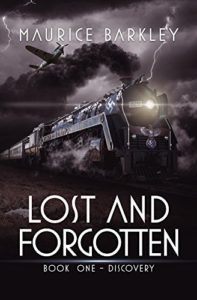 Title: Lost and Forgotten
Title: Lost and Forgotten
Author: Maurice Barkley
Designer: Ivan Zanchetta
Genre: Thriller
Graphics: This is an especially well done cover. Let me begin by pointing out something that makes it “work”: the dark area at the bottom. The designer prudently didn’t try to fill the whole space with a complex image. He left room at the bottom for the title, which stands out nicely. Imagine if the whole cover were as complex in detail as the locomotive. How could text be placed atop the image without obscuring a key part of it or without the text becoming hard to read?
The story takes place chiefly in the present, but showing a Nazi train and plane, even if only referring to the backstory, immediately suggests to the reader a tie to the past. I do have one question and one quibble.
Did locomotives of the 1940s have bells at the front, to warn of the train’s approach? Maybe they did, but, given the size and presumed loudness of this locomotive, it seems that a bell hardly could be heard above the clatter of the wheels and the roar of the engine.
The quibble concerns the lightning bolt that seems to be striking the bell. Perhaps the lightning is intended to be in the distant background, as at the upper left, and perhaps the bell just happens to be obscuring lightning that is far behind it, but it almost looks as if the illustrator is trying to convey a message by having lightning hit the bell. (If so, it would be a remarkably small bolt.)
Typography: A single font is used on this cover. It reminds me of James Hilton’s Lost Horizon, a story that takes place in the 1930s (even though I can’t locate a cover of that book that uses this font). In other words, this font evokes a period, and the period it evokes is the 1930s through the end of World War II, so it is quite appropriate here.
As I said, the designer prudently left lots of dark room at the bottom for the title to pop. Unfortunately, the same can’t be said about the top of the image and the author name, which is in thinner letters and against a less-contrasting background.
I would have put the author name in bold but kept it at the same size. The bottom of the text rests against the plane’s propeller and the locomotive’s smoke, so I would have pulled the image down slightly. I wouldn’t have done the simpler thing of raising the author name because that would have placed it too close to the top.
What about the tagline, “Book One—Discovery”? It isn’t clear how to interpret this. Is Lost and Forgotten the first book in a series called Discovery, or is Discovery the first book in a series called Lost and Forgotten?
I presume the former, since it would be strange to have the real title, Discovery, in such small text and the series title, Lost and Forgotten, looking like a title. If my presumption is correct, then I would have reworded the tagline to read “Book One in the Discovery Series,” or something like that.
The one element I would drop from the cover is the rule separating the title from the tagline. It’s unnecessary, since no one will read the tagline as part of the title, and it also conflicts graphically with the rest of the image. It’s the kind of rule one might find on a science fiction cover: galaxy-like, it’s more prominent in the center and fades at the two sides. Even in color tone it doesn’t match anything else on the cover.
Overall: Despite a few reservations, this cover must be counted a success. I suspect few aficionados of the thriller genre would pass this book by if they saw it on a bookstore shelf. The well-done illustration is enough to attract even people whose preferences lie with other genres.
